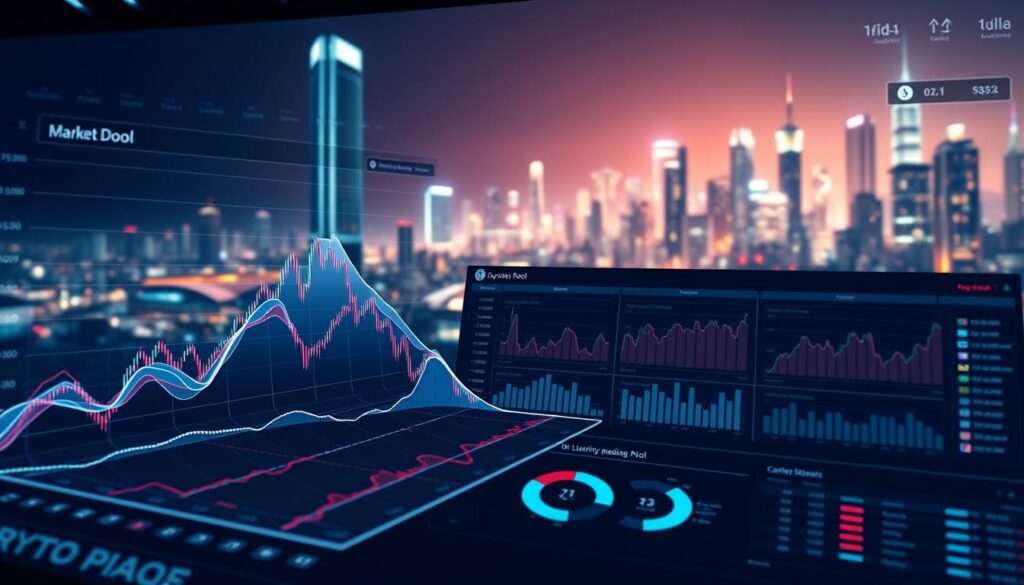Now Reading: How to Analyze Crypto Liquidity Pools: A Step-by-Step Guide
- 01
How to Analyze Crypto Liquidity Pools: A Step-by-Step Guide
How to Analyze Crypto Liquidity Pools: A Step-by-Step Guide

In any financial system, liquidity is the essential element that determines how easily assets can be bought or sold. This concept is just as critical in the world of digital assets. A deep and active market allows for smooth trading without causing drastic price swings.
Decentralized finance, or DeFi, relies on a revolutionary tool called liquidity pools. These pools act as automated market makers, enabling direct peer-to-peer trading without a central intermediary. Participants deposit pairs of tokens into a smart contract, creating a shared resource for asset exchange.
Understanding the mechanics of these liquidity pools is vital for anyone involved in DeFi. This guide provides a clear path to evaluating the health and potential of different pools. A solid grasp of crypto liquidity fundamentals helps investors make informed decisions and manage risk effectively.
Key Takeaways
- Liquidity is the measure of how easily an asset can be traded without impacting its price.
- Liquidity pools are the core infrastructure of decentralized exchanges, replacing traditional order books.
- These pools function as automated market makers, allowing for seamless token swaps.
- Providers fund pools by depositing two tokens, earning fees from the trading activity.
- Proper analysis is crucial for assessing risk and identifying profitable opportunities within DeFi.
- This guide will explore key metrics and strategies for evaluating pool health.
Introduction to Crypto Liquidity Pools
The foundation of decentralized finance rests on accessible trading mechanisms that ensure smooth asset conversion. These systems enable direct peer-to-peer exchanges without traditional intermediaries.
Understanding the Basics of Liquidity in Crypto Markets
Liquidity measures how easily digital assets can be bought or sold without major price changes. Deep markets allow for efficient trading with minimal disruption.
Traditional exchanges rely on order books matching buyers and sellers. Liquidity pools offer an automated alternative using smart contracts. These contracts hold token pairs ready for instant swaps.
The Role of Liquidity Providers in Decentralized Trading
Individual participants become liquidity providers by depositing equal values of two tokens into pools. They earn fees from each trade executed through their contributed assets.
Most pools use the constant product formula (x * y = k) to maintain price stability. Token quantities adjust automatically after every transaction. This mathematical relationship ensures continuous market function.
Providers receive LP tokens representing their pool share. These tokens can be redeemed for original assets plus accumulated fees. This system democratizes market-making activities for all participants.
The Importance of Market Liquidity and Trading Volume
Market activity levels directly influence the ease of executing trades in digital asset exchanges. High activity often signals a healthy, efficient marketplace for participants.
Key metrics provide a clear picture of this environment. Understanding these indicators is crucial for assessing any asset’s tradability.
Measuring Trading Volume and Its Impact on Liquidity
Trading volume represents the total value of assets bought and sold within a specific period. It serves as the primary gauge for market health.
Higher volume typically indicates deeper liquidity. This allows for executing large orders without major price changes.
A consistently high trading volume suggests strong interest from both buyers and sellers. This creates a robust and stable trading environment.
Exploring Order Book Depth and Bid-Ask Spreads
The bid-ask spread is the difference between the highest buy order and the lowest sell order. Tighter spreads are a hallmark of liquid markets.
When many participants are active, the spread narrows significantly. This reduces costs for everyone involved in trading.
Order book depth shows the volume of buy and sell orders at different price levels. A deep order book with symmetrical buy and sell orders indicates strength. It means large trades can be processed smoothly.
How Liquidity Influences Price Stability and Volatility
Sufficient liquidity is essential for accurate price discovery. It ensures that prices reflect true supply and demand.
Markets with deep liquidity absorb large orders easily. This prevents wild price swings and reduces overall volatility.
Conversely, low liquidity can lead to significant price impacts from single trades. Assets become harder to buy or sell at desired prices.
| Feature | High Liquidity Market | Low Liquidity Market |
|---|---|---|
| Trading Volume | Consistently High | Erratic or Low |
| Bid-Ask Spread | Narrow / Tight | Wide |
| Price Impact of Large Orders | Minimal (Low Slippage) | Significant (High Slippage) |
| Price Volatility | Generally Lower | Generally Higher |
This relationship between volume, depth, and stability forms the foundation for evaluating any trading arena. Recognizing these signs helps participants navigate markets effectively.
how to analyze crypto liquidity pools
Evaluating the health of a decentralized trading venue requires a systematic look at several key performance indicators. These metrics reveal the efficiency and stability of the marketplace.
Start by examining the Total Value Locked (TVL). This figure represents the total capital deposited. A higher TVL generally indicates greater confidence and a larger resource for traders.
Step-by-Step Metrics and Analytical Strategies
Next, assess the trading volume. Look at 24-hour and weekly data. Compare this volume to the TVL. A healthy ratio shows active use of the pool’s resources.
The bid-ask spread is another vital sign. A narrow spread means lower costs for participants. It signals a deep and active market.

Market depth charts are essential tools. They display the volume of buy sell orders at different price levels. This reveals how well the pool can handle large orders.
Key Indicators: Low Liquidity, Order Imbalances, and Market Depth
Watch for warning signs of low liquidity. These include wide spreads and high slippage. Slippage measures the price impact of a trade.
An imbalance between buyers and sellers can also be a red flag. A large number of sell orders compared to buy orders may signal price pressure.
- Volume-to-TVL Ratio: Measures actual pool utilization.
- Tight Bid-Ask Spreads: Indicate lower transaction costs.
- Deep Order Books: Show capacity for large trades.
- High Slippage: Suggests a shallow pool.
Using these strategies helps identify the most efficient venues for trading digital assets.
Navigating Automated Market Makers and Order Book Dynamics
Algorithmic pricing models have transformed how digital assets are traded by eliminating traditional matching systems. These automated systems use mathematical formulas to determine prices instantly.
Understanding the AMM Model and Constant Product Formula
Automated Market Makers (AMMs) operate through smart contract technology. They maintain continuous liquidity without requiring direct buyers sellers matching.
The most common formula is x * y = k. This constant product relationship ensures price adjustments after each trade. Token quantities change automatically to maintain balance.

Comparing DEX Models: Uniswap, SushiSwap, and Curve
Different platforms optimize for various trading scenarios. Uniswap uses the basic constant product model for diverse token pairs.
Curve specializes in stable assets with minimal slippage. SushiSwap enhances the basic model with additional reward features. Each platform offers unique advantages for liquidity providers.
| Platform | Primary Focus | Key Advantage | Slippage Level |
|---|---|---|---|
| Uniswap | General token pairs | Broad asset support | Moderate to High |
| Curve | Stablecoin pairs | Minimal price impact | Very Low |
| SushiSwap | Community rewards | Additional incentives | Moderate |
Understanding these differences helps participants choose the right platform. Each model serves specific trading needs within the decentralized ecosystem. For a deeper exploration of AMM mechanics, see this detailed guide on automated market makers.
Risk Management: Impermanent Loss, Slippage, and Smart Contract Security
Managing financial exposure in digital asset markets demands careful consideration of several critical factors. Participants face unique challenges that require strategic planning.

Understanding these risk elements helps maintain portfolio stability. Each factor impacts potential returns differently.
Strategies to Mitigate Impermanent Loss in Liquidity Pools
Impermanent loss occurs when token values diverge significantly from initial deposit ratios. This opportunity cost can reduce overall returns for providers.
Selecting pools with correlated assets minimizes this risk. Stablecoin pairs typically experience less price divergence. Monitoring market volatility patterns helps anticipate potential losses.
Calculating potential impermanent loss before committing capital is essential. This proactive approach informs better decision-making.
Managing Slippage and Understanding Gas Fees
Slippage measures the difference between expected and actual trade execution prices. High slippage suggests insufficient depth in the marketplace.
Traders can minimize slippage by splitting large orders into smaller portions. Executing trades during high-liquidity periods also reduces price impact.
Network congestion often increases transaction costs significantly. Optimizing timing helps control expenses associated with trading activities.
| Risk Type | Primary Cause | Impact Level | Mitigation Strategy |
|---|---|---|---|
| Impermanent Loss | Token price divergence | Medium to High | Correlated asset pairs |
| Slippage | Low market depth | Low to Medium | Split large trades |
| Smart Contract Risk | Code vulnerabilities | Very High | Verified audits |
| Gas Fee Volatility | Network congestion | Low to Medium | Off-peak trading |
Proper risk assessment balances potential trading fees against exposure to losses. Diversification across multiple venues spreads exposure effectively.
Leveraging Liquidity Pools within the DeFi Ecosystem>
Modern decentralized financial platforms build their operations around collective asset reserves that power various services. These shared resources form the backbone of peer-to-peer financial networks.
Protocols utilize these foundational elements to create sophisticated banking alternatives. This infrastructure supports lending, borrowing, and derivative products without traditional intermediaries.
Integrating Liquidity Pools for Yield Farming and Liquidity Mining
Yield farming involves strategic allocation across multiple venues to maximize returns. Participants carefully assess reward rates and risk exposure when selecting positions.

Liquidity mining programs offer additional incentives beyond standard transaction revenue. These initiatives help bootstrap new platforms while distributing governance rights.
Lending protocols like Aave and Compound create decentralized money markets using these shared resources. Interest rates adjust automatically based on supply and demand dynamics.
| Strategy Type | Primary Focus | Risk Level | Potential Returns |
|---|---|---|---|
| Stablecoin Farming | Price stability | Low | Moderate |
| Governance Mining | Token accumulation | Medium | High |
| Correlated Assets | Impermanent loss protection | Medium | Medium-High |
| New Protocol Bootstrapping | Early adoption rewards | High | Very High |
The composability of these systems creates layered opportunities. LP tokens can serve as collateral in other protocols, generating additional revenue streams.
Effective participation requires diversification and continuous market monitoring. This approach balances potential rewards against various risk factors.
Practical Guide: Tools, Wallets, and Joining Liquidity Pools
Getting started as a liquidity provider involves selecting the right digital wallet and understanding platform interfaces. This practical approach ensures smooth participation in decentralized markets.
Setting Up Your Crypto Wallet and Necessary Tools
Choosing a compatible digital wallet is the first essential step. MetaMask serves as a popular browser extension for Ethereum-based platforms.
Trust Wallet and Coinbase Wallet offer mobile alternatives with broad network support. Each option provides secure storage for digital assets.
Step-by-Step Process to Provide Liquidity on DEXs
Begin by connecting your wallet to a chosen decentralized exchange. Navigate to the pool section and select your desired token pair.
The interface displays expected returns and fee structures clearly. Ensure equal dollar values of both tokens before confirming your deposit.
Review all transaction details including gas fees and slippage settings. This careful approach protects your investment while maximizing potential earnings.
Conclusion
Navigating the complex world of automated market making demands a thorough understanding of multiple performance indicators. Successful participants in digital asset markets recognize that deep liquidity provides essential advantages.
Liquid markets enable smoother transactions with reduced costs and better price discovery. Both traders and investors benefit from these efficient environments when executing trades.
Effective participation requires balancing potential rewards against various risk factors. A comprehensive approach to evaluating shared asset reserves considers volume metrics, price stability, and platform security.
Starting with established venues builds confidence before exploring emerging opportunities. Continuous monitoring and proper risk management remain crucial for long-term success in decentralized finance.
FAQ
What is the main difference between an Automated Market Maker (AMM) and an order book exchange?
An AMM, like Uniswap, uses a smart contract and a mathematical formula to set asset prices based on the supply within a pool. An order book exchange, such as Binance, matches individual buy and sell orders from traders. AMMs provide continuous liquidity, while order books offer more precise price discovery but can suffer from low liquidity for certain trading pairs.
How does low liquidity affect my trade on a decentralized exchange?
Low liquidity leads to high slippage. This means the final execution price of a large order can be significantly worse than the expected price. It increases trading risk and cost. High trading volume and deep market depth are signs of a healthy, liquid market that minimizes this issue.
What is impermanent loss, and how can I manage the risk?
Impermanent loss occurs when the price of your deposited assets in a pool changes compared to when you deposited them. This results in less value than simply holding the assets. To manage risk, consider pools with stable assets or correlated pairs, like stablecoins on Curve Finance, which experience lower volatility.
Why is the bid-ask spread an important metric for traders?
The bid-ask spread represents the difference between the highest price a buyer will pay and the lowest price a seller will accept. A narrow spread indicates a liquid market with high trading efficiency, lowering costs for participants. A wide spread suggests low trading volume and higher risk for investors executing trades.
What tools can I use to analyze the health of a liquidity pool?
Key tools include blockchain explorers like Etherscan to view pool size and trading volume. Analytics platforms like Dune Analytics and DeFi Pulse offer data on Total Value Locked (TVL), asset composition, and fee generation. Monitoring these metrics helps assess market depth and the pool’s overall activity.
How do liquidity providers earn yield from pools on platforms like SushiSwap?
Providers earn a share of the trading fees generated from every swap that occurs in the pool. Additionally, many protocols offer liquidity mining incentives, rewarding providers with extra tokens. This combination of trading fees and rewards creates the annual percentage yield (APY) for participants.











